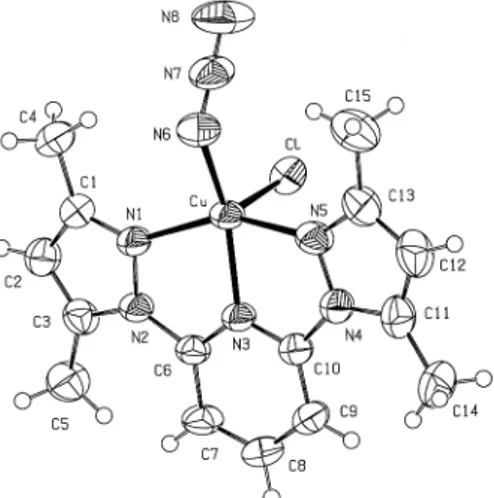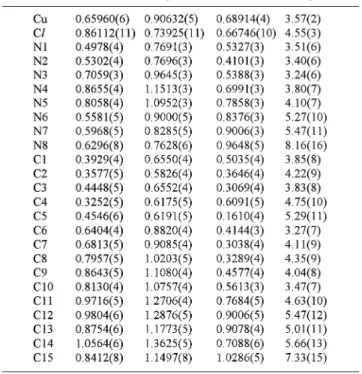Crystal structure of [2,6-bis(3,5-dimethyl-N-pyrazolyl)pyridine](azido)(chloro)copper(II)
Tam metin
(2) 336 Table 1. ANALYTICAL SCIENCES FEBRUARY 2003, VOL. 19 Crystal and experimental data. Formula: C15H17N8ClCu Formula weight = 408.35 Space group: P1¯ Crystal system: triclinic Z=2 a = 8.6450(12)Å b = 10.0026(11)Å c = 10.7953(13)Å α = 111.297(3)˚ β = 96.260(2)˚ γ = 93.958(4)˚ V = 858.59(18)Å3 Dx =1.580 g/cm3 µ(Cu Kα) = 3.367 mm–1 T = 293 K Color = dark green Radiation Cu Kα (λ = 1.5418 Å) 0.30 × 0.25 × 0.20 mm 2θmax = 74.2˚ No. of reflections = 3463 No. of reflection used = 3149(I > 2σ (I)) No. of parameters = 227 R = 0.067 Rw = 0.185 Goodness-of-fit = 1.12 (∆ρ)max = 0.73 eÅ–3 (∆ρ)min = –0.61 eÅ–3 Measurement: Enraf-Nonius CAD-4 Program system: WinGX package Structure determination: SHELXS97 Refinement: full matrix least-square SHELXL97 Treatment of hydrogen atoms: geometric calculation. Table 2 Final atomic coordinates and equivalent isotropic thermal parameters for non-hydrogen atoms Atom. x. y. z. Beq. Beq = (8π2/3)ΣiΣjUijai*aj*(ai·aj).. Table 3. Selected bond distances (Å) and angles (˚). Table 4. Hydrogen bonding geometry (Å, ˚). Acknowledgements The authors wish to acknowledge the purchase of the CAD4 diffractometer under Grant DPT/TBAG1 of the Scientific and Technical Research Council of Turkey and acknowledge the financial support of Ankara University Research Fund (Project No. 20010705052).. References 1. P. Manikandan, K. R. J. Thomas, and P. T. Manoharan, Acta Crystallogr., 2000, C52, 308. 2. P. Manikandan, K. R. J. Thomas, and P. T. Manoharan, J. Chem. Soc., Dalton Trans., 2000, 2779. 3. N. Kitajima, K. Fuijisawa, C. Fujmoto, Y. Moro-oka, S. Hashimoto, T. Kitagawa, K. Toriumi, K. Tatsumi, and A. Nakamura, J. Am. Chem. Soc., 1992, 114, 1277. 4. E. I. Solomon, M. J. Baldwin, and M. D. Lowery, Chem. Rev., 1992, 92, 521. 5. D. L. Jameson and K. A. Goldsby, J. Org. Chem., 1990, 55, 4992.. Symmetry codes: (i) 1–x, 1–y, 1–z (ii) x, y, 1 + z (iii) –x, –y, 1–z.. 6. R. Cortes, L. Lezama, J. I. R. Larramendi, M. Insausti, J. V. Folgado, G. Madaraiga, and T. Rojo, J. Chem. Soc., Dalton Trans., 1994, 2573..
(3)
Şekil


Benzer Belgeler
2. Standart Model kuark ailelerini gösteriniz. Kuarkların özellikleri hakkında bilgi veriniz. Dört temel etkileşmeyi dikkate alarak aşağıdaki tabloyu doldurunuz. Aracı parçacık
ÖLÇME, DEĞERLENDİRME VE SINAV HİZMETLERİ GENEL MÜDÜRLÜĞÜ KİTAPÇIK TÜRÜ A.. Cevaplarınızı, cevap kağıdına
ÖLÇME, DEĞERLENDİRME VE SINAV HİZMETLERİ GENEL MÜDÜRLÜĞÜ KİTAPÇIK TÜRÜ A.. Cevaplarınızı, cevap kağıdına
Dördü 35 ten büyük olan 6 farklı çift doğal sayının toplamı
ÖLÇME, DEĞERLENDİRME VE SINAV HİZMETLERİ GENEL MÜDÜRLÜĞÜ KİTAPÇIK TÜRÜ A.. Cevaplarınızı, cevap kâğıdına
ÖLÇME, DEĞERLENDİRME VE SINAV HİZMETLERİ GENEL MÜDÜRLÜĞÜ KİTAPÇIK TÜRÜ A.. Cevaplarınızı, cevap kâğıdına
ÖLÇME, DEĞERLENDİRME VE SINAV HİZMETLERİ GENEL MÜDÜRLÜĞÜ KİTAPÇIK TÜRÜ A.. Cevaplarınızı, cevap kâğıdına işaretleyiniz.. T.C. Mustafa Kemal, Sofya’da Osmanlı
ANLATIM BİÇİMLERİ VE DÜŞÜNCEYİ GELİŞTİRME YOLLARI Anlatım Biçimleri Açıklayıcı Anlatım (Açıklama) Öyküleyici Anlatım (Öyküleme) Betimleyici Anlatım